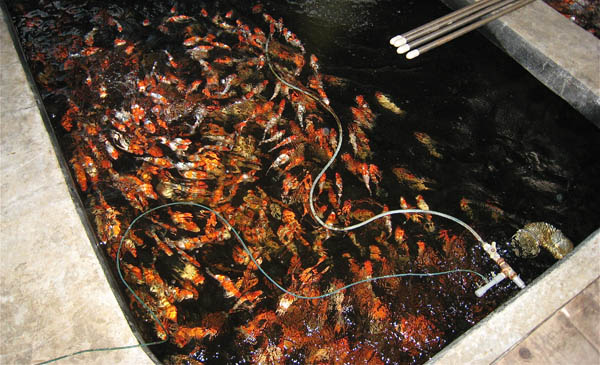Today we can still find some outlets displaying ponds full of ‘not so good Japanese Koi’ for sale. I have seen the prices they are offered for and, bearing in mind that I can accurately estimate the cost of the Koi when purchased in quantity in Japan, I also know all the costs involved in running a legitimate (well – almost!) Koi business for many years.
Let’s ‘generalise’ a little more regarding ‘not so good Japanese Koi’ when purchased in the highest quantity possible to get the lowest purchase price possible direct from the breeder – and assuming no agents and middle men are involved from purchase to arrival in the sales ponds back home. Of course, there are many classes of Koi breeder also, these prices relate to the more famous outlets. All prices mentioned are in Japanese Yen.
A breeder has 3,500 tosai averaging 22cms for sale in April and these Koi have not yet been purchased before by any other buyer. He terms them as his ‘tateshita’ and these are all Go-Sanke varieties.
1. He will sell ALL for 2,275,000yen (averaging 650yen per Koi) – his very best price so do not ask for further discount.
OR
2. He will sell 2,000 of the same (at ‘scoop’ rate – not selected) for 2,500,000yen (averaging 1,250yen per Koi).
OR
3. He will sell 1,000 of the same (at ‘scoop’ rate) for 1,650,000yen (averaging 1,650yen per Koi).
OR
4. He will sell 500 of the same (buyer can select) for 2,000,000yen (averaging 4,000yen per Koi).
OR
5. He will sell 100 of the same (buyer can select) for 1,000,000yen (averaging 10,000yen per Koi).
OR
6. He will sell 50 of the same (buyer can select) for 1,650,000yen (averaging 33,000yen per Koi).
OR
7. He will sell 25 of the same (buyer can select) for 2,000,000yen (averaging 80,000yen per Koi).
Now let us consider costs in getting these above options back home, they need to be correctly packed (this is provided free from charge by the breeder), they need to be inspected by the veterinarian for a health certificate (only 5,000yen), they need to be transported from the breeder’s premises directly onto the airplane which is some 150 miles away, after cargo space has been reserved for a particular flight and they then need to be sent by air to their final destination.
In Japan, freight companies like T-Cat & Kin-Tetsu Express play a great part in this specialised transportation, they can get the cargo through customs after paying the required airport taxes and charges. To save time here, as it varies with the amount of cartons on a particular shipment, I will generalise as to costs involved per carton but before I do we need to mention packing quantities and weights of a carton when sealed.




